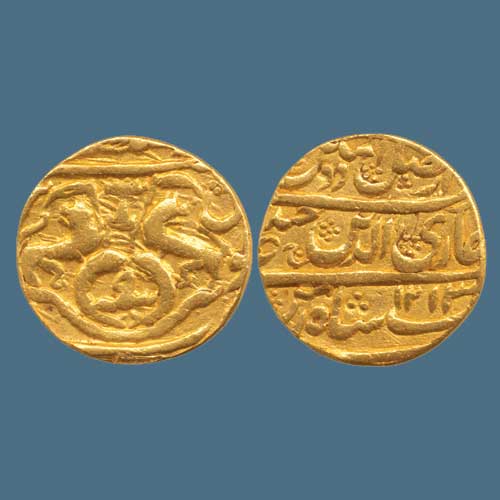Half-Ashrafi of Awadh Nawab
2018-11-20 Tue
Princely State Awadh can be traced its origin from the ancient Hindu kingdom of Kosala, with the Ayodhya as its capital. In the medieval times, Awadh is also mentioned during the reign of Mughal Emperor Akbar. In the British historical text, it is mention as ‘Audh’ or ‘Oudh’. The region is located in the Indian states of Uttar Pradesh.The Nawabs of this state traced their origin to ‘Muhammad Amin’, a Persian adventurer who served the Mughal Emperor, 'Muhammad Shah’. Muhammad Amin was appointed as the Subahdar of Awadh in 1720 AD. In the later period, Awadh declared its independence due to the decline of the Mughal Empire.
< br> This very rare gold Half-Ashrafi was issued by Ghazi-ud-din Haidar; he had ruled Awadh from the year 1819 CE to 1827 CE. He issued coins in all three metals gold, silver and copper. This gold Half Ashrafi which was introduced by him weighs around 4.8g. It was introduced by him during the 9th year of his reign. This gold Half-Ashrafi has an error in Hijri year; The Hijri year in this is inscribed as 1213. The obverse of this coin is inscribed with the name and title of the king with the Hijri year 1213 and the reverse of the coin is inscribed with the coat of arms with the regnal year 9. This gold Half-Ashrafi is listed for INR 90,000 in the upcoming auction which will be held in Mumbai on 24th November 2018.
Image Courtesy: Todywalla Auction
Latest News
-
Panchala King Bhanumitra Copper Coin
2024-04-26 FriThe Panchala kingdom was ruled by the Mitra kings. The Mitra kings are known to issue coins and most...
-
Mahatma
2024-04-25 ThuIndia Post issued a commemorative postage stamp on #LalaHansraj, also known as Mahatma Hansraj for�...
-
Berar Mint of Muhammad Akbar
2024-04-25 ThuBerar was a kingdom located in the Deccan region, with Elichpur as its capital. It was one of the Su...
-
Janma Kalnayak of Bhagwan Mahavir
2024-04-24 WedOn 21st April 2024 which was the 2550th Janma Kalnyanak of Bhagwan Mahavir Swami, PM Modi unveile...
-
Gold Pagoda of Vijaynagar Empire King Deva Raya I
2024-04-10 WedKing Deva Raya I of the Vijayanagara Empire was a patron of Kannada literature and architecture. He ...

